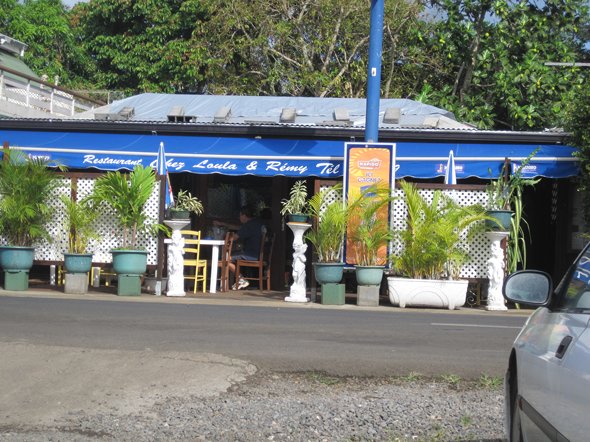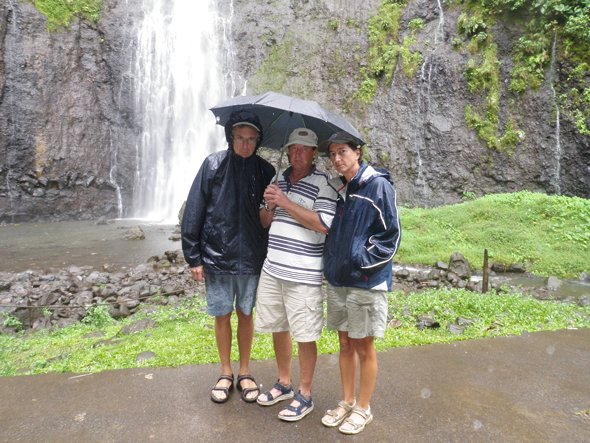The Society Islands - Tahiti S17 30 W148 30

|
Tahiti
In the wake of Captain James Cook, who carefully charted most of the south Pacific as we know it, we have now sailed on to Tahiti some 220 miles south west of Toau our last port of call in the Tuamotus. Like the Marquesas, the Societies are high, volcanic islands of jagged towers and peaks and they are surrounded by wide coral reefs. Although it has been very windy here the climate is very pleasant with much less humidity than we experienced in the Marquesas. Below the breaking waves is a solid wall of coral which circles the island. Once through a pass the coral creates calm lagoons inside which provide peaceful but sometimes rather windy anchorages.
Cook spent several weeks in Otaheite (Tahiti) in 1769 undertaking his commission to observe the transit of the planet Venus. Although other navigators had visited the Society Islands, it was this visit of Cook's that brought the island to the world's attention. When in 1772 he left Plymouth once again, this time in the Resolution, along with companion ship the Adventure, he was on a mission to seek out new land between South America and New Holland, now Australia. He nearly discovered Antarctica but gave up too soon and headed north east then east to Aetorea now called New Zealand. During this voyage he revisited Tahiti and made a detailed survey. We have seen the chart, it is stunningly accurate and detailed. The most amazing thing about all this is that Cook managed to get his ship through the South Pacific islands intact. Having sailed through the reef passes to get into anchorages in Tahiti, and other islands in the Northern groups of Polynesia, with our GPS, depth sounder, chart plotter and pilot books Chris and I can only marvel at a man who had such a level of seamanship that he got his ship through these reefs and through his surveys laid the foundations of Pacific navigation for generations to follow.
Tahiti Landfall Cook was a careful visitor, he came and went as an observer taking care not to have too much impact on the environment he was experiencing. He was followed by those, including missionaries, with less scruples about radically changing the culture of the Pacific peoples. This has continued apace in Tahiti – the flesh pots of Tahiti is a phrase sometimes heard. We haven't found those, we are not quite sure what it means but it is the most developed place since Panama City. Perhaps 'the flesh pots' refers to the large Carrefour supermarkets, the abundant French and Chinese restaurants, the big four wheel drive vehicles, the plethora of jewellery stores and the abundance of XXXL clothing in the shops. We have been grateful for the supermarkets as the last time we were able to fully provision the boat was in Panama back in April. Tahiti is almost two islands Tahiti Nui, the larger part, and Tahiti Iti the smaller part joined together by an isthmus. The bulk of the main island is very high and rugged with dense vegetation, it is mainly uninhabited and largely unexplored as the terrain is so difficult. Consequently there is one road which goes right around the coast with a few spurs venturing a little inland. The road has a continuous string of settlements, villages and businesses which are well developed. It is busy and turns into a major dual carriageway as it reaches the capital Papeete which is much like many popular French cities – the restaurants are good but at Polynesian prices they don't come cheap. One excellent way of dining out in Tahiti is to wait until evening when 'Les Roulottes' roll in and set up their tables and charcoal grills. Each van turned restaurant has its own cuisine and certain charm. We dined out at one of the Roulouttes that set up outside the Tahiti Yacht Club, the food and service was excellent and the place was busy all evening with local families and foreign visitors like us, very enjoyable. There is plenty of oriental choice alongside the Polynesian as Tahiti has a huge Chinese community, many of the businesses are in Chinese ownership and there are masses of Chinese shops with their 'Made in China' goods.
Excellent French restaurant where we had a delicious lunch. We chose to pick up a mooring at the Tahiti Yacht Club rather than use the main and crowded anchorage at the capital Papeete. This was really successful as we had a secure mooring buoy whilst experiencing some very strong winds. The small bay is traversed by various outrigger canoes from singles to 6 man paddlers which are a joy to watch, Chris is very keen to try one, they look stable but we have seen one overturn and needing rescue as they are difficult to get back up if the outrigger goes down. The Polynesians love their canoes and they can be seen all day long on the water but at about 5 o'clock when the day's work is done they fill the bays with their bright colours gliding over the water like slender fish.
Tahiti Canoe Club on the left and Tahiti Yacht Club on the right.
We ended up staying a total of 13 days in the bay. Lorraine was unwell for the first few days with flu like symptoms. A bit of a surprise as she had not been ashore since the Tuamotus when she developed the symptoms. However, treatment with some Panamanian antibiotics did the trick and we were able to tour the island in a hire car amongst other things. The road around the island was a bit of a disappointment as so much of the coastal fringe is developed. We also chose a bad day when it decided to do the rain bit of the tropical rain forest thing. This made this waterfall rather more impressive than the one in the Marquesas we went to see, but made us a bit damp.
Chris with our friends James and Lucy enjoying the weather! The day brightened up eventually and we went inland to find a viewpoint which took us through some farmland that could have been in southern England with meadows, hedgerows and cows grazing.
Some of the crops were less recognizable. This we think is taro, with a banana hedgerow.
We completed a number of boat jobs whilst in the anchorage including getting the mainsail repaired where it had a small tear. It is surprising how long even small jobs like this take without a car or a local telephone. The other thing that slowed us down a little is that there was a sociable bar at the yacht club where we met other yachties. Being on a boat with a moat of water around can make it a bit difficult to meet people. However, in this picture there are citizens of UK, US, Germany and Austria.(The man sitting down in the blue shirt is an ex Head of English from the north-west who like me took early retirement to sail). The average age of cruisers is about our age and it is quite unusual to meet many people as young as Boz, the American standing up.
We are glad that we stopped at Tahiti, it is after all the capital city of French Polynesia let alone the Society Islands. It afforded us convenience with its good facilities for laundry and shopping, repairs, restocking on fishing tackle and replacing worn out clothing. We are not sorry to be leaving, happy to leave the flesh pots behind! |









